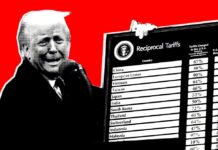As Juliet Eilperin and I report, any effort to halt new oil and gas permits on federal acreage will face significant legal and political hurdles — including from many Democrats in oil-producing states.
Nowhere is the tension within the Democratic Party over the issue of a potential drilling ban greater than in New Mexico.
The spotlight on the Land of Enchantment, which has voted blue in all but one presidential election since 1992, comes as Biden appears primed to pick a New Mexico Democrat to be his interior secretary. Rep. Deb Haaland and Sens. Tom Udall and Martin Heinrich are each in the running to be Biden’s top public lands manager.
Whoever is chosen will be charged with trying to wind down the oil and gas leasing program that has financially benefited the state, should Biden follow through on his campaign promise.
For years, New Mexico politicians have talked about the dire need to address climate change as the Southwest region faces deadly heat waves and prolonged droughts. Yet at the same time, pumpjacks bobbing across the desert landscape funnel money to local governments and school districts through royalty payments and other drilling fees.
The state accounts for 57 percent of oil production on federal land and nearly a third of onshore gas extraction, according to a recent industry analysis released in September in anticipation of the battle over drilling, which projected New Mexico could lose $1 billion a year in federal revenue if all drilling activity ceased.
Ending new oil and gas drilling “would be a very detrimental hardship to New Mexico,” said Betty Read Young, president of a small, 18-employee oil producer in Roswell, N.M. called Read & Stevens, Inc. “I challenge them to come up with another industry in New Mexico that can generate” that money.
Neighboring Texas may have a bigger name in the oil business and more of the Permian Basin in its backyard, but New Mexico’s largely federally controlled southeast corner is rich in petroleum, too.
“Our rocks are better than what they’ve got on the Texas side of the Permian,” said Ryan Flynn, head of the New Mexico Oil and Gas Association. “Texans, they’ll run me out of town.”
New Mexico Democrats are apprehensive about the burgeoning demand for a leasing ban.
As almost every Democrat seeking the presidential nomination promised to ban new drilling on federal lands. Gov. Michelle Lujan Grisham (D), a Biden ally, said she would ask for an exemption from any ban.
And after the final presidential debate, Rep. Xochitl Torres Small, who represents New Mexico’s 2nd Congressional District, which covers the Permian, said she would “stand up to my party when they’re out of touch with the reality” after Biden suggested he would “transition” away from oil. The freshman congresswoman was in a race tight reelection race that she ended up losing on Nov. 3.
Udall and Heinrich have expressed reservations about a total ban.
In a recent interview, Udall, whose father ran the Interior Department in the 1960s, called for setting a goal of “carbon-neutral” public lands, where the emissions from fossil fuel extraction could be offset by reforestation and other activities that remove carbon from the atmosphere. “That’s where we should be headed,” he said.
“Go into the departments that have the expertise and have the scientists and tell them this is your goal,” Udall added. “How do we get there? What do we need to do? And then you can reapproach this in a concrete way and get it done.”
Heinrich also opposed outright bans during the Democratic primary, although he wants the United States to move away from fossil fuels.
But Haaland, who would be the first Native American to run the department that oversees federal and tribal lands, is more open to a straightforward ban. In September, she told reporters, “We don’t need drilling everywhere.”
Methane, a greenhouse gas that can be more than 80 times more potent than carbon dioxide, frequently escapes from oil patches in New Mexico and elsewhere. Haaland was referring to methane leaks when she added, “If I had my way, it’d be great to stop all gas and oil leasing on federal and public lands, because those lands belong to all of us; they don’t just belong to one sector.”
Power plays
The Trump administration’s race to roll back environmental regulations before leaving office continues.
- A rule that went into effect Thursday gives U.S. Forest Service officials broad leeway to bypass environmental review requirements under the National Environmental Policy Act. Conservationists say that the exclusions will allow widespread development without input from local communities, our colleagues Darryl Fears and Juliet Eilperin report.
- Meanwhile, the Bureau of Land Management released plans that will ease sage grouse protections in the West, potentially opening up more areas in Idaho, Wyoming, Colorado, Utah, Nevada, northeastern California and Oregon to widespread mining and oil drilling, the Associated Press reports.
- And the Interior Department on Thursday moved to relax Obama-era safety regulations for Arctic offshore drilling. A proposed rule would roll back requirements that oil operators show they can quickly deploy containment equipment in case of a spill, among other changes. Biden is likely to throw out the proposed rule once he takes office, Reuters reports.
EPA Administrator Andrew Wheeler is squeezing in two taxpayer-funded foreign trips before leaving office.
Wheeler is planning to charter a flight to Taiwan at a cost of $250,000 in December before a scheduled trip to four Latin American countries the following month. “Both trips have raised concerns about the taxpayer expense at a time when Mr. Wheeler no longer represents the direction of E.P.A. policy, and he and top aides are supposed to be aiding the transition to the Biden administration,” the New York Times reports.
The administration is chartering a flight to Taiwan in part to avoid coronavirus risks and the quarantine required for commercial travelers. Two aides told the Times the meetings for the Taiwan trip, which cover marine life protection and air quality, were cobbled together at the last minute and there have been no stated policy goals for the Latin America trip, which could include Panama, Costa Rica, Ecuador and the Dominican Republic.
Wheeler’s visit comes just a few months after Health and Human Services Secretary Alex Azar went to Taiwan, the highest-level visit by a Cabinet secretary since 1979, when the United States severed formal ties with the island nation in order to cement diplomatic relations with China. That trip was widely seen as part of the Trump administration’s ongoing push to counter China’s growing influence in the region.
Wheeler’s predecessor, Scott Pruitt, drew scrutiny for expensive travel on the taxpayer’s dime. “Administrator Wheeler remains head of the agency and will continue to advance environmental progress both here and abroad,” spokesperson James Hewitt told The Energy 202 in a statement.
Erin Brockovich objects to chemistry industry consultant on Biden’s EPA transition team.
Brockovich, an environmental advocate who was subject of a titular film starring Julia Roberts, argues that Matthew McCabe should be excluded from the Biden transition because of his work with chemical maker DuPont. The Biden team has named McCabe, who previously worked as an aide to Biden and as deputy administrator at the EPA under the Clinton administration, to the agency transition team.
“Let us not bring the fox back into the hen house,” Brockovich writes. “It should go without saying that someone who advised DuPont on how to avoid regulations is not someone we want advising this new administration.”
McCabe worked on behalf of DuPont to lobby against regulations for the toxic chemical PFOA, which has been linked to negative health impacts, according to the Intercept.
Thermometer
U.S. greenhouse gas emissions fell to their lowest level in three decades amid the coronavirus pandemic.
The U.S. economy, slowed by the pandemic, is projected to have generated 5.9 billion metric tons of emissions, a 9 percent fall compared to 2019, our colleague Steven Mufson reports. “As a result, the United States has been inadvertently pushed back on track to meet the commitments the Obama administration made at the Paris climate agreement in December 2015,” Mufson writes.
The decline in emissions, however, was partially offset by massive wildfires that swept the West Coast and Rocky Mountains this year and released carbon dioxide and other pollutants into the air. Emissions are also likely to increase again as the economy rebounds.
Climate change is taking a toll on Massachusetts’ cranberry crop.
Farmers are used to unpredictable weather. But some are finding the extreme summer heat, warm winters with less ice and rapid fluctuations outside the range of normal are taking a toll on Massachusetts’ second-largest agricultural commodity.
“Farmers are employing new technology and altering some traditional practices to keep alive a fruit that dates to native tribes and has been associated with this state since the first Thanksgiving in Plymouth,” Tatiana Schlossberg writes for The Washington Post.
But many farmers face an uphill battle. Changing climate means that cranberry plants, some of which are more than 100 years old, are budding earlier in the spring, making them vulnerable to frost as temperatures fluctuate. In the summer, bogs can be 10 to 20 degrees hotter than the outside temperature, cooking berries on the vine.
The bogs themselves, however, are beneficial to the environment, helping preserve surrounding marshes that protect biodiversity and wildlife, and vegetation and trees that capture carbon dioxide.
GM will bring 30 all-electric vehicles to market in the next five years.
General Motors had previously said that it would bring 20 electric vehicles to market by 2023. On Thursday, GM chief executive Mary Barra bumped that number up to 30 models by 2025 in a presentation to the Barclays Global Automotive Conference, saying that 40 percent of vehicles would be battery-electric by mid-decade, the Detroit Free Press reports.








